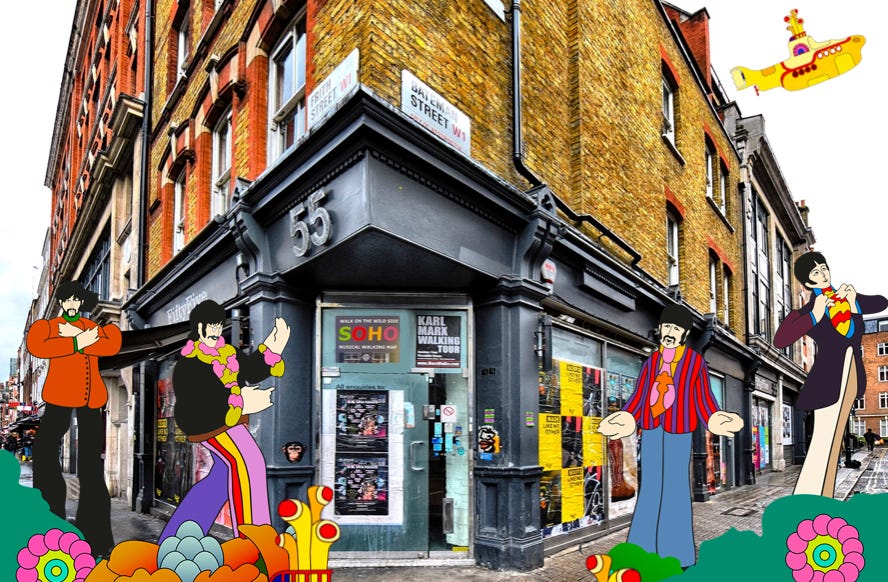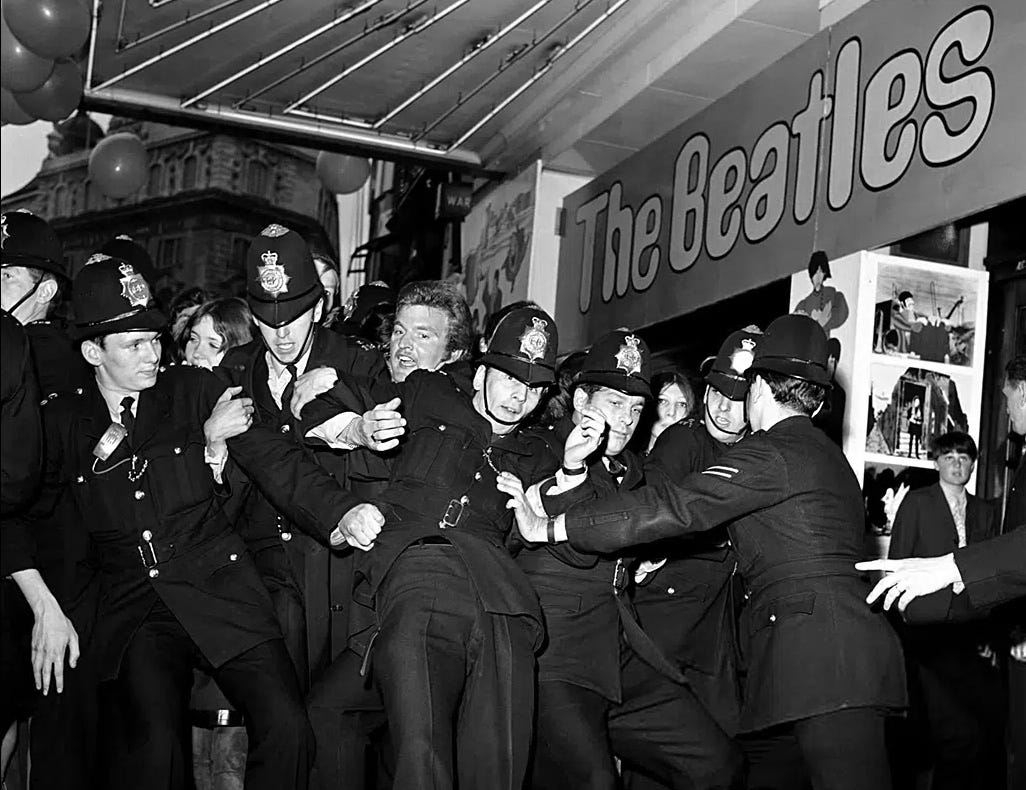65-66 Dean Street, Soho, may not look like the birthplace of a cultural revolution. The building dates from the late 1950s and was constructed on a wartime bombsite, adjoining a short terrace of Grade II-listed Georgian townhouses. The decorative brickwork and railing at the front are very much of their time. Today, it is home to post-production facilities for Goldcrest, where visual effects for Slow Horses, Bad Sisters, Nosferatu, and Wonka, among many other film and TV projects, have been created.
Back in 1968, it was the offices of TVC London, a team of dedicated animators and illustrators who brought to life Yellow Submarine, the groundbreaking animated feature film featuring The Beatles. This film is the most successful of all the band’s multimedia projects and had a significant impact on the future development of animation. Some have argued that making the film propelled animation in the UK to another level and was a factor in the country’s dominant role in post-production.
The film’s creation was fuelled by artistry, ambition, and a genuine commitment to faithfully translating The Beatles’ music into a rich visual experience. Doing this within a tiny budget is a testament to the filmmakers' innovation and sheer creative will.
TVC London and Their Beatles Connection
Filmmaker George Dunning had long envisioned setting up an independent animation studio in London. In 1957, TV Cartoons, later renamed TVC London, was established to meet the needs of the advertising industry, working on brands such as Mother’s Pride Bread and the National Coal Board. Their work developed into animated series for TV and film projects such as the opening sequence of the 1964 Pink Panther movie. It was this expertise that caught the attention of American producer Al Brodax, who contracted TVC to create The Beatles cartoon television series for US television.
The cartoon series was never shown in the UK, though in North America, it gained high ratings for daytime television. The band themselves were less than enthusiastic about their cartoon likenesses. However, it was the success of the series that led Brodax to propose a full-length animated feature.
In 1964, The Beatles had signed up with United Artists for a three-movie deal, only two of which had been delivered. Various projects were proposed, including The Jungle Book, for which The Beatles would record the music and briefly appear in the film. John Lennon, in particular, was very much opposed. He was pitching for The Lord of the Rings (with himself as Gollum), although this was vetoed by Tolkien’s estate.
Then, according to Philip Norman in Shout!, “a script was commissioned from Joe Orton, the young, working-class dramatist whose macabre comedies, Loot and Entertaining Mr. Sloane, had each been huge West End successes.” In the words of Orton himself, his script required the band to “have been caught in-flagrant, become involved in dubious political activity, dressed as women, committed murder, been put in prison, and committed adultery.” The script was rejected.
The idea of an animated film became increasingly attractive, as they wouldn’t actually have to act in it—or indeed do anything—apart from providing four ‘new’ songs alongside existing ones. In any case, 1968 was a very busy year. They had just made their own film—Magical Mystery Tour—spent time in India with the Maharishi, launched Apple Corps, mentored and produced artists for their new record label, and were recording what became their White Album. The idea was that the film would more or less make itself.
Dean Street: A Hub of Creative Energy
In their Dean Street studio, Dunning and his team were determined to elevate Yellow Submarine beyond the aesthetic of the television series. Their idea was to embrace psychedelia while creating something uniquely artistic and experimental. The challenge was to do this on a budget of £250,000—around one-quarter of what a regular animated feature film would cost.
The turning point came with the recruitment of German illustrator Heinz Edelmann. Inspired by the sartorial style and surreal visuals of the previous year’s Strawberry Fields Forever promo film, Edelmann submitted four stylised drawings of the band. These bold designs—so unlike anything Disney-style—set the visual tone for the film.
Just around the corner from their studio, the Dog and Duck pub became an informal workspace for the Yellow Submarine team, where they often discussed ideas over pints. Edelmann drew inspiration from John Lennon’s poetry collections, refining the film’s narrative to reflect The Beatles’ artistic growth and values.
The first sequence to be made was the three-minute Sgt. Pepper’s Lonely Hearts Club Band sequence, included towards the end of the film to demonstrate how the ideas would work. Following its test screening, the project was given full approval, and work intensified at the Dean Street offices.
Innovation Under Pressure
Unlike traditional animation projects, which often followed rigid structures, Yellow Submarine was created in an evolving, free-form manner. Edelmann proposed that the animation style should shift every few minutes to maintain audience engagement. To meet the demanding eleven-month production schedule, TVC London hired over 200 artists, many recruited directly from local art schools. The teams operated around the clock, with night-shift workers ferried in by bus, provided with meals, and frequently ending or beginning their shifts at the Dog and Duck.
Actors were hired to voice the band members and other characters, including Liverpool TV and stage actor Paul Angelis, who was initially appalled that the script was in Americanised English. He introduced Liverpool poet Roger McGough to the project, ensuring the dialogue reflected the band’s authentic Liverpudlian wit.
With limited time and budget, the team turned to unconventional animation techniques. The Eleanor Rigby sequence used photographs of real buildings instead of drawn backgrounds, incorporating images of the animators themselves, including Edelmann and even the landlord of the Dog and Duck, holding a dog on a lead. This blend of photographic elements with animation prefigured the collage aesthetic that would later be popularised by Terry Gilliam of Monty Python.
Other creative solutions included rotoscoping, in which live-action footage was traced to create fluid movement, notably in the Lucy in the Sky with Diamonds sequence. Special effects director Charlie Jenkins devised innovative approaches to animating complex scenes, such as the undulating waves in the Sea of Science and the surreal, ever-changing Sea of Holes—a sequence so technically challenging that the team celebrated its completion with an all-night drinking session at the Dog and Duck.
Impact and legacy
As the film neared completion, The Beatles’ scepticism faded. They attended screenings of completed segments and, impressed by the creative direction, began to embrace the project. The film premiered on 17 July 1968 at the London Pavilion, on the southwest corner of Soho at Piccadilly Circus. Just two days earlier, The Beatles had moved into their new Apple Corps HQ in Savile Row. While their personas had moved on considerably from the Fab Four, that evening’s reception as they arrived at the cinema took them right back to the heady days of their initial fame. Deafening screams filled Piccadilly Circus, and the police struggled to hold the crowds back. That night was the last ever display of Beatlemania.
The impact of Yellow Submarine extended far beyond its 1968 release. The film introduced generations of children to The Beatles, bridging the gap between musical and visual storytelling. Moreover, it fostered an enduring spirit of experimentation in animation, inspiring future artists and filmmakers.
John Lasseter, who directed Toy Story, has previously headed both Pixar and Walt Disney Animation. He described Yellow Submarine as a “revolutionary work” that “paved the way for the fantastically diverse world of animation that we all enjoy today.” Simpsons writer Josh Weinstein says that the film “Without Yellow Submarine there would never have been The Simpsons, no Futurama, no South Park, no Toy Story, no Shrek.”
And it may sound corny, but driving this whole project forward and making it happen… was love. Weinstein continues: “So how did all this happen? Well, here I do need to get into a little back-story, because it's an important lesson in how brilliant things get produced. It's how The Simpsons came to be, and it's how Yellow Submarine happened. It's called trusting in artists and letting them do their stuff. It's also called I-have-no-idea-what-those-hippies-in-Soho-are doing-but-it-has-the-Beatles'-name-on-it-so-I-guess-we'll-make-money. From what I've read, the pressure these artists felt came from not wanting to let the Beatles down because they loved them and their music so much. That's a great sort of pressure to be under.”
The theme of love infused Yellow Submarine in other ways too. The collaborative and free-spirited nature of the production led to lasting relationships among the illustrators—so much so that within a few years, at least thirteen children were born to couples who had met while working on the film.
Soho has always thrived on a dynamic mix of artistic freedom, collaboration, and openness. The creation of Yellow Submarine on Dean Street exemplifies the area’s ability to foster creative risk-taking, where bold ideas emerge from communities of artists, illustrators, and filmmakers. Fuelled by the energy of its pubs, clubs, and studios, Soho has long been a hub of cultural production, shaped by its willingness to embrace the contribution of people from around the world. The legacy of Yellow Submarine is not just in its influence on animation but in its reaffirmation of Soho as a place where creativity flourishes—not because of vast resources, but because of passion, trust, and the willingness to push beyond boundaries.
Today, while 65-66 Dean Street may seem unremarkable, it stands as a testament to one of the most innovative and critically significant animated films of all time, proving that great art doesn’t require a great budget. All you need is love.







As a Beatles fan of many years standing I've always felt that my knowledge of the Yellow Submarine animated feature film has been sadly lacking. However, your article on the background to, and production of, the film filled so many gaps for me. Thank you for delving into it and sharing your knowledge.
Wonderful! so interesting, thanks Mike.